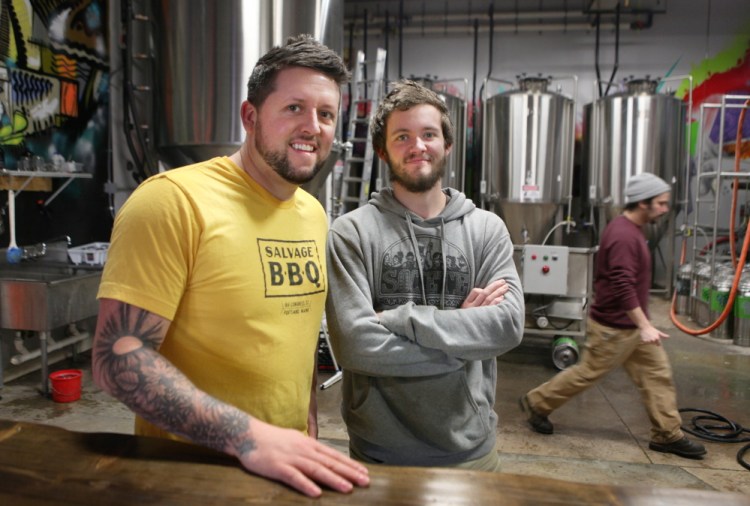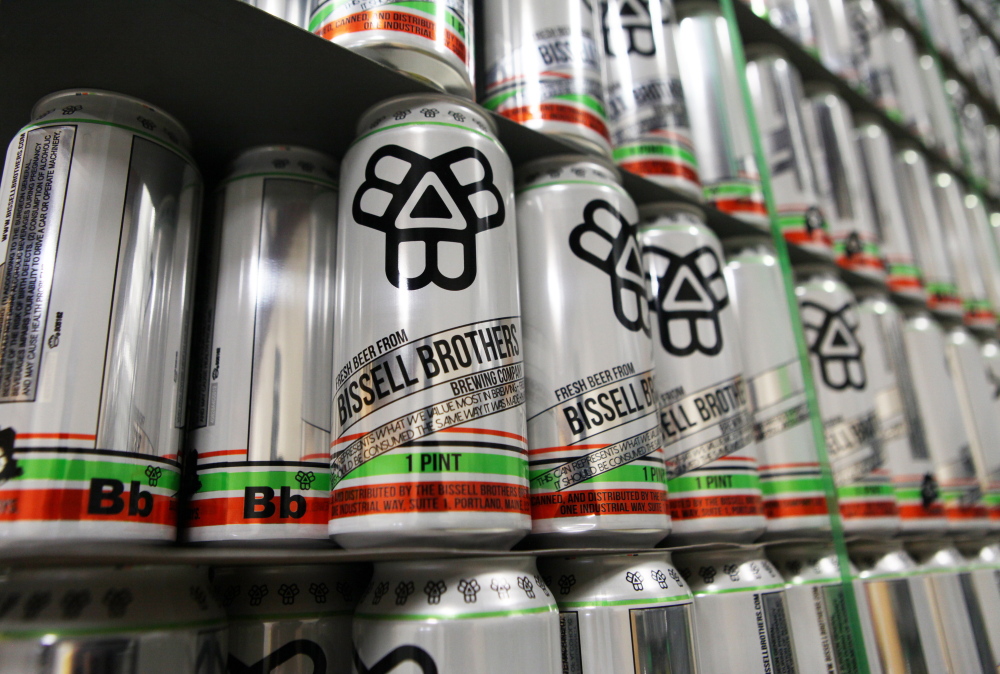When Peter and Noah Bissell launched their small brewery in Portland in December 2013, they, like every entrepreneur, hoped customers would buy their product, tell a friend or two and come back and buy some more. What happened, though, far surpassed their wildest dreams.
On an average Saturday afternoon at Bissell Brothers Brewing Co., people start lining up around 12:30, a half-hour before the brewery and tap room opens its doors at 1 p.m.
“No matter how much we seem to have, the beer is pretty much gone by 2,” said Noah, the 25-year-old head brewer. “Even in our wildest dreams we were so conservative compared to what’s actually happened.”
The brothers have been told a thousand times that it’s a good problem to have when you can sell everything you make. But, good or not, it creates challenges in juggling expectations and handling frustrated customers who wait 45 minutes in line only to watch the last four-pack of The Substance Ale, the Bissell brothers’ flagship beer, be sold to the person in front of them.
“Noah and I have been told 3,000 times that it’s a good problem to have,” said Peter, who’s 31 and acts as the business manager. “People may say that, but it’s still a problem and it can be very painful because you are being pulled at all these different ends.”
One problem may be that the average person doesn’t understand how a brewery works, which leads to customers telling the brothers that they just need to brew more beer to meet the demand. Sadly, it’s not that simple. A brewery works under a variety of inherent limitations, including space and availability of ingredients, especially hops, which is an agricultural product and therefore limited in the amount produced each year.
“For any brewery, there’s a finite amount of beer you can make depending on how much capacity you have in your tanks,” Noah said. “It’s frustrating when people come in and say, ‘well, why don’t you just make more,’ like it’s something you haven’t thought about. It’s frustrating on our end because a lot of people don’t understand that’s not a possibility for a brewery our size, even if we had unlimited amounts of money.”
In the end, it’s all about fermentation tanks. Noah and the crew could brew beer 24/7, but if they have no where to put the beer while it ferments, then it’s pointless.
Bissell Brothers Brewing Co.’s flagship beer is a hoppy American-style India Pale Ale called The Substance Ale. The brewery has a brewing system that can produce roughly 300 gallons per batch and began with two fermentation tanks, each of which could hold 600 gallons. Noah and the crew began by brewing once a week and brewing two batches that day to fill one tank. The Substance needs to ferment for at least two weeks, so the tanks would be alternatively filled and emptied every two weeks, giving them a weekly production of 600 gallons. They realized quickly, however, that they needed to increase that amount, which presented the brothers with a tough decision. Though still in debt after the business launch, should they drop another $10,000 or $15,000 on a deposit for a third fermentation tank that would help them keep pace with demand?
“It was tough going and we’d truly exhausted all the money we started with and were still in a pretty big hole of debt,” Noah said. “It’s kind of cliche, but the only way to make money was to spend money. It was a tough decision at the time to drop 10 or 15 grand on that when we could barely keep the lights on, but we decided it’s what we needed to do.”
The bet, made in only two months after opening, paid off. The third fermentation tank increased their production capacity, but the lines to buy beer at the brewery continued to grow as word spread. A few months ago, the brothers invested in a fourth fermentation tank – this one about twice the size of the three existing ones and has the capacity to hold roughly 1,200 gallons.
They expect the new capacity will not only allow them to produce more of The Substance, but also expand the line of other beers they produce. Bissell Brothers produced four beers in 2014 (about 30,000 gallons in all), but Noah expects to have eight beers on rotation in 2015.
At this point, the brothers could move to a larger space, keep adding fermentation tanks and flood the southern Maine market to its saturation point. But they won’t, opting instead for a slow and deliberate expansion.
The Substance Ale is made to be drunk fresh, so any chance that the beer would be made, canned and then sit on a shelf somewhere for a week would sacrifice the integrity of the product, Noah said.
“In a perfect world, we’d produce as much as we could while still ensuring that all the beer we make in a week is sold that week,” Noah said. “I think we’re still a long way from there, but by necessity and design we’ll grow slowly because we don’t want to make too big a leap to a point where our beer is sitting.”
Increasing the amount of beer the brewery can produce addresses the problem, but it doesn’t solve the ongoing challenge of how to manage customer expectations for a product that can be hard to find.
For that, the brothers have depended on clear communication and transparency.
“What it really boils down to is education,” Peter said.
The brothers have been forced to balance competing desires. While even local customers can find it hard to get their hands on a four-pack of The Substance, the pair gets asked all the time by craft beer fans in Massachusetts and New York, and from as far away as California and Colorado, when the Bissell Brothers will begin distributing in those states.
“The answer is never, unless something drastically changes in our ethos. This is a Portland brewery. That doesn’t mean we won’t need to expand to meet that demand, but we’re here and freshness is paramount,” Peter said, comparing the state of the craft beer industry to pre-Prohibition, when each city had a number of breweries that served, in some cases, a local neighborhood.
“The more we’re able to educate people, the more they understand, ‘Well, I should stop looking for it in Boston, I should stop looking for it in upstate New York. What I should do is get some friends together and we should go to Portland, Maine, for the weekend.’
“That’s been one of the big problem solvers: educating people on what we want to do as a brewery, but also educate them about how to get the beer.”
Send questions/comments to the editors.




Comments are no longer available on this story